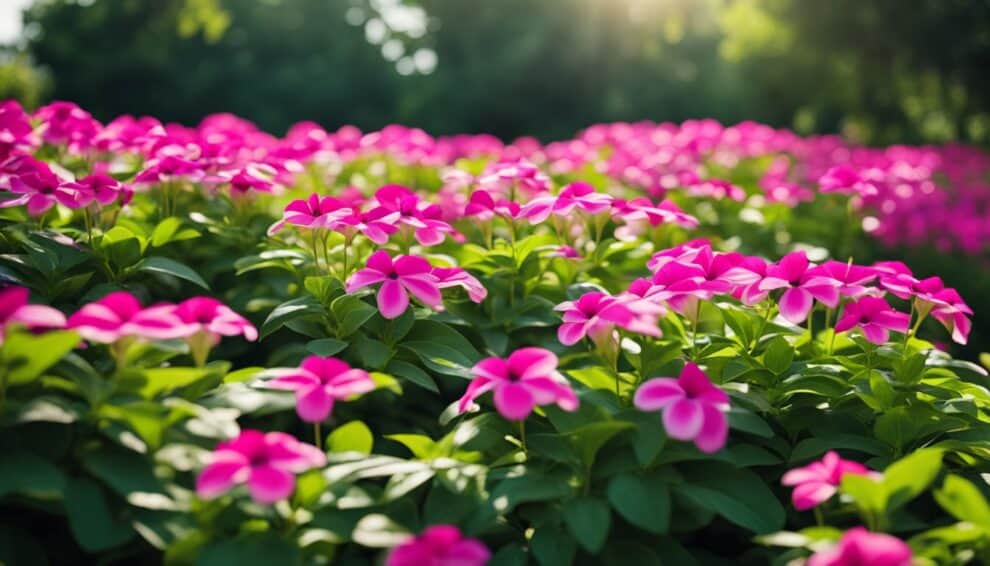Catharanthus roseus, commonly known as the Madagascar periwinkle, is a beautiful and fascinating plant that has captured the attention of many gardeners and botanists alike.
This tropical plant is native to Madagascar, but it has now spread to other parts of the world, including Asia, Australia, and the Americas.
The Madagascar periwinkle is a member of the Apocynaceae family, and it is known for its striking flowers and medicinal properties.

One interesting fact about Catharanthus roseus is that it has been used for centuries in traditional medicine to treat a variety of ailments.
The plant contains alkaloids, which are chemical compounds that have been shown to have anti-cancer properties.
In fact, two alkaloids found in the Madagascar periwinkle, vincristine and vinblastine, have been used to treat leukemia and other types of cancer.
These alkaloids work by interfering with the division of cancer cells, thereby slowing down or stopping the growth of tumors.
Another fascinating aspect of Catharanthus roseus is its wide range of flower colors.
The plant produces flowers in shades of pink, red, white, and purple, and these colors can vary depending on the variety of the plant.
The flowers are also known for their unique shape, which resembles a pinwheel.
The Madagascar periwinkle is a popular choice for gardeners who want to add a splash of color to their gardens, and it is also a favorite of florists who use the flowers in arrangements and bouquets.
Botanical Profile
Species Classification
Catharanthus roseus, commonly known as Madagascar periwinkle, is a species of flowering plant in the dogbane family, Apocynaceae.
It is native to Madagascar, but has been widely cultivated and naturalized in tropical and subtropical regions worldwide.
The plant was first described by the French botanist Charles Plumier in 1703. It was later named by Carl Linnaeus in 1753.
Physical Characteristics
Madagascar periwinkle is a small evergreen shrub that grows up to 1 meter tall.
It has glossy dark green leaves and produces a profusion of flowers in shades of pink, red, white, and lavender.
The flowers are about 2.5 cm in diameter and have a distinctive shape with five petals arranged in a star-like pattern.
The plant has a deep root system and prefers well-drained soil.
It is often grown as an ornamental plant in gardens and parks, but is also used in traditional medicine for a variety of ailments.
Madagascar periwinkle contains a number of alkaloids, including vincristine and vinblastine, which have been used to treat cancer.
However, these compounds can be toxic and should only be used under the guidance of a qualified healthcare professional.
Overall, Madagascar periwinkle is a fascinating plant with a rich history and many interesting properties.
Medicinal Properties

Alkaloids and Compounds
Catharanthus roseus is known for its medicinal properties, thanks to the presence of more than 100 alkaloids and other compounds.
The two most important alkaloids found in the plant are vincristine and vinblastine, which are used to treat cancer.
These alkaloids work by interfering with the growth of cancer cells, preventing them from dividing and spreading.
Other alkaloids in the plant, such as ajmalicine and serpentine, have been used to treat high blood pressure, diabetes, and malaria.
These alkaloids have antihypertensive, hypoglycemic, and antimalarial properties, respectively.
Traditional and Modern Uses
Catharanthus roseus has been used in traditional medicine for centuries, particularly in Madagascar, India, and China.
In Madagascar, the plant is used to treat a variety of ailments, including diabetes, dysentery, and malaria.
In India, the plant is used to treat high blood pressure, while in China, it is used to treat coughs and colds.
In modern medicine, Catharanthus roseus is used primarily to treat cancer.
Vincristine and vinblastine, the alkaloids found in the plant, are used to treat a variety of cancers, including leukemia, lymphoma, and breast cancer.
In addition, the plant has been used to treat other conditions, such as diabetes, high blood pressure, and malaria.
Overall, Catharanthus roseus is a fascinating plant with a long history of medicinal use.
Its alkaloids and other compounds have been used to treat a variety of conditions, and its potential as a cancer treatment continues to be explored.
Cultivation and Care

Growing Conditions
Catharanthus roseus, commonly known as Madagascar periwinkle, is a tropical plant that requires warm temperatures to grow.
It thrives in full sun but can also tolerate partial shade. The soil should be well-draining and rich in organic matter.
It is important to maintain consistent soil moisture, but avoid overwatering as it can lead to root rot.
Propagation Techniques
Madagascar periwinkle can be propagated through seeds or cuttings.
Seeds can be sown directly into the soil or started indoors and transplanted outside once the seedlings have reached a height of 2-3 inches.
Cuttings should be taken from healthy plants and rooted in a well-draining potting mix.
Once the roots have formed, the cuttings can be transplanted into the ground.
Regular pruning is important to promote bushy growth and prevent legginess. Deadheading spent flowers can also encourage more blooms.
Fertilizing with a balanced fertilizer every 4-6 weeks during the growing season can help promote healthy growth and blooming.
Overall, with proper care and attention, Madagascar periwinkle can be a beautiful addition to any tropical garden.
Environmental Significance

Habitat and Distribution
Catharanthus roseus, commonly known as Madagascar periwinkle, is a beautiful and eye-catching plant that is native to Madagascar.
It is a tropical plant that thrives in warm and humid climates. The plant is well adapted to grow in a variety of soils, ranging from sandy to clayey soils.
Madagascar periwinkle can be found growing in the wild in many parts of the world, including Africa, Asia, and Australia.
The plant has also been introduced to other parts of the world, where it has become naturalized.
It is commonly grown as an ornamental plant in gardens and parks, and it is also used in traditional medicine to treat a range of ailments.
Conservation Status
Catharanthus roseus is not considered to be a threatened species, but it is still important to conserve the plant and its habitat.
The plant is a valuable source of medicine, and it is also an important ornamental plant.
However, the plant is threatened by habitat loss, primarily due to deforestation.
In addition, the plant is also threatened by invasive species that compete with it for resources.
Efforts are being made to conserve the plant and its habitat. One such effort is the establishment of protected areas where the plant can grow and thrive.
In addition, there are also programs in place to educate people about the importance of conserving the plant and its habitat.
These efforts are crucial in ensuring that Catharanthus roseus continues to thrive for generations to come.
Frequently Asked Questions

What medicinal properties does Catharanthus roseus possess?
Catharanthus roseus contains alkaloids that have been found to possess antitumor, antihypertensive, and anti-inflammatory properties.
They are also used to treat diabetes, malaria, and Hodgkin’s disease. The plant has been used in traditional medicine for centuries.
How does the Madagascar Periwinkle adapt to different environments?
The Madagascar Periwinkle is a hardy plant that can adapt to a variety of environments. It is drought-tolerant and can survive in poor soil conditions.
It prefers full sun but can also grow in partial shade.
What role does Catharanthus roseus play in traditional medicine?
Catharanthus roseus has been used in traditional medicine for centuries to treat a variety of ailments.
It has been used to treat diabetes, malaria, and Hodgkin’s disease. It is also used to treat high blood pressure and as a sedative.
Can you explain the significance of alkaloids found in the Madagascar Periwinkle?
The alkaloids found in the Madagascar Periwinkle have been found to possess antitumor, antihypertensive, and anti-inflammatory properties.
They are also used to treat diabetes, malaria, and Hodgkin’s disease.
These alkaloids have been the focus of much research, particularly in the area of cancer treatment.
What are the ideal growing conditions for Catharanthus roseus?
Catharanthus roseus prefers full sun but can also grow in partial shade. It requires well-draining soil and can tolerate drought conditions.
It is a hardy plant that can adapt to a variety of environments.
How has Catharanthus roseus contributed to cancer research?
Catharanthus roseus has been the focus of much research in the area of cancer treatment.
The alkaloids found in the plant have been found to possess antitumor properties, and two of these alkaloids, vincristine and vinblastine, are used in chemotherapy to treat a variety of cancers.
The plant continues to be an important source of research for cancer treatments.














